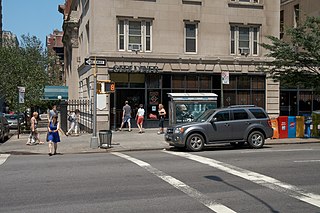
Shreve, Lamb, and Harmon, founded as Shreve & Lamb, was an architectural firm best known for designing the Empire State Building, the tallest building in the world at the time of its completion in 1931. The firm was prominent in the proliferation of Art Deco architecture in New York City.

Trowbridge & Livingston was an architecture firm based in New York City, active from 1897 to 1925. The firm's partners were Breck Trowbridge and Goodhue Livingston. They were successors to the firm Trowbridge, Colt & Livingston, founded in 1894 but dissolved in 1897 when Stockton B. Colt left the partnership.

The Million Dollar Corner is a small building next to Macy's Herald Square at 1313 Broadway, at the corner with 34th Street, in Herald Square, Manhattan, New York City. On December 6, 1911, the five-story building sold for a then-record $1 million.

Clinton and Russell was a well-known architectural firm founded in 1894 in New York City, United States. The firm was responsible for several New York City buildings, including some in Lower Manhattan.

Robert Henderson Robertson was an American architect who designed numerous houses, institutional and commercial buildings, and churches. He is known for his wide-variety of works and commissions, ranging from private residences such as Jacqueline Kennedy's childhood home Hammersmith Farm and the Adirondacks Great Camp Santanoni, great civic buildings like Southport's Pequot Library for the Marquand Family to some of the earliest steel skyscrapers in New York City.

George E. Harney was a late 19th-century American architect based in New York City.

Cast Iron House at the corner of Franklin Street and Broadway in the Tribeca neighborhood of Manhattan, New York City, formerly known as the James White Building, was built in 1881–82 and was designed by W. Wheeler Smith in the Italianate style. It features a cast-iron facade, and is a good example of late cast-iron architecture. The building was renovated by architect Joseph Pell Lombardi in 2000, and a restoration of the facade began in 2009. The building once housed the offices of Scientific American from 1884 to 1915, but it was primarily used in connection with the textile trade.

89th Street is a one-way street running westbound from the East River to Riverside Drive, overlooking the Hudson River, in the New York City borough of Manhattan. The street is interrupted by Central Park. It runs through the Upper West Side, Carnegie Hill and Yorkville neighborhoods.

Elliott Lynch, AIA, was an American architect active in the late 19th and early 20th centuries in New York City. His office was located at 347 Fifth Avenue in Manhattan. Many of the buildings he designed remain standing.

The Cornwall, at 255 West 90th Street, is a luxury residential cooperative apartment building on the Upper West Side of Manhattan, New York City. Located on the northwest corner of Broadway and 90th Street, it was designed by Neville & Bagge and erected in 1909. The developers were Arlington C. Hall and Harvey M. Hall. The twelve-story brick and stone building is noted for its elaborate balcony and window detail, and the "spectacular" design of its "extraordinary" ornate Art Nouveau cornice, which the AIA Guide to New York City called "a terra-cotta diadem." In 1991, the building's owner-occupants paid $600,000 to have the cornice and ornamented balconies replaced with terra cotta replicas of the originals.

15 Broad Street is a residential condominium and former office building in the Financial District of Manhattan, New York City, on the eastern side of Broad Street between Wall Street and Exchange Place. It has entrances at 51 Exchange Place and 35 Wall Street.

Herman Lee Meader was an American architect and author.

Daniel D. Badger was an American founder, working in New York City under the name Architectural Iron Works. With James Bogardus, he was one of the major forces in creating a cast-iron architecture in the United States. Christopher Gray of The New York Times remarks: "Most cast-iron buildings present problems of authorship – it is hard to tell if it was the founder or the architect who actually designed the facade."

Henry V. Murphy (1888–1960) was an American architect who specialized in Catholic churches and schools.

John Butler Snook (1815–1901) was an American architect who practiced in New York City. He was responsible for the design of a number of notable cast-iron buildings, most of which are now in and around SoHo, Manhattan, as well as the original Grand Central Depot, which preceded the current Grand Central Terminal.

Alfred J. R. E. Zucker was a German-American architect, who worked in Galveston, Texas, Mississippi, New York City, and Buenos Aires.

William H. Hume was an American architect in New York City.

935–939 Broadway is a six-story Italianate brownstone structure designed by the architect Griffith Thomas in the Flatiron District of Manhattan, New York City.

The New York County National Bank Building at 77–79 Eighth Avenue at West 14th Street in the Greenwich Village neighborhood of Manhattan, New York City – also known as the Manufacturers Hanover Trust Company Building – was built in 1906–07 and was designed by De Lemos & Cordes and Rudolphe L. Daus in the Neoclassical style. A seven-story addition to the south of the building at 75 Eighth Avenue was constructed in 1926. Renovations and a further addition in 1999 were by Lee Harris of the Hudson River Studios and John Reimnitz and mimic the original architecture.

Mount Sinai West, opened in 1871 as Roosevelt Hospital, is affiliated with the Icahn School of Medicine at Mount Sinai and the Mount Sinai Health System.






















